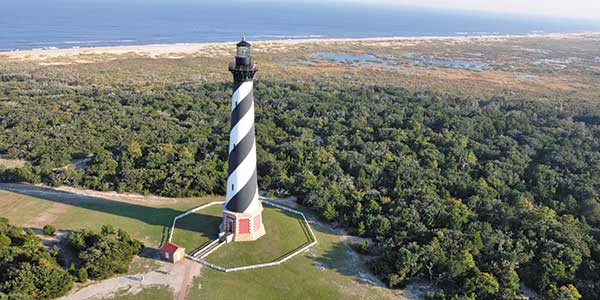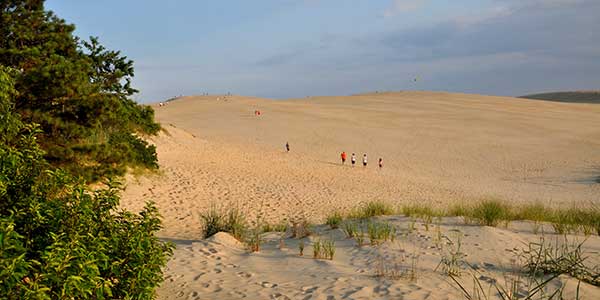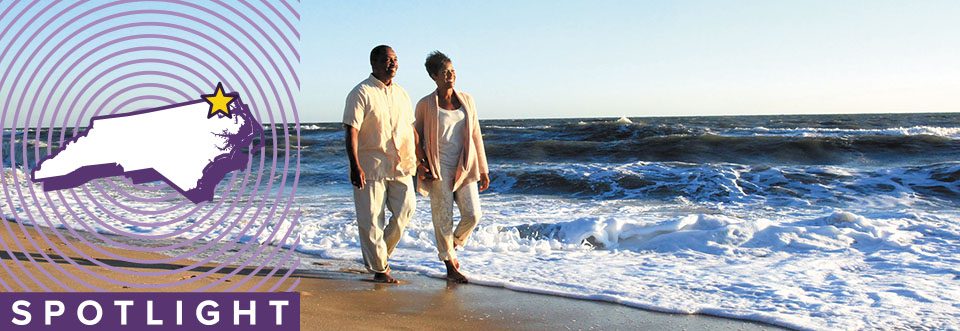Outer Banks/Cape Hatteras
Fly with the Wrights and climb the dunes on an Atlantic Coast getaway
The singularly beautiful barrier islands that form North Carolina’s Outer Banks constitute one of the nation’s more alluring coastal destinations, and for a good reason. Timeless seascapes, a primal aura (once you escape the tourist summer onslaught), cultural attractions and historical touchstones provide a recreational wonderland for all ages. East Coast vacations don’t get much more well-rounded than Outer Banks excursions, complete with wind-swept colonial enclaves, iconic lighthouses, free-roaming ponies, a much-storied maritime history (the infamous “Graveyard of the Atlantic” sits off the coast) and a monument dedicated to the fathers of flight.
Cape Hatteras
With its secluded, undiscovered aura and laid-back vibe, the pristine barrier island of Hatteras Island feels a world apart from the more developed northern Outer Banks. Popular with outdoor enthusiasts, time moves to its own rhythms and pleasures are of the natural kind. You won’t find any golden arches here. Tradition holds sway as every business is passionately owned and managed by locals. With a renowned charter fleet, fishing in Hatteras Village is king. From the Ocracoke Ferry Terminal, day trips to Ocracoke Island traverse the Hatteras Inlet, where seagulls squawk and dolphins frolic (if you’re lucky, you’ll catch sight of these playful creatures).
Some 75 percent of Hatteras Island is protected as part of Cape Hatteras National Seashore. Here, magnificent sand dunes, swaths of white sand fringed with forest and fecund marshlands provide the backdrop to on-the-water recreation, including crabbing (for prized blue crabs), snorkeling, surfing, canoeing and windsurfing.

The Outer Banks
While here, check out the historic lighthouses that grace the Cape. Known for its black-and-white-striped daymark pattern, the Cape Hatteras Light Station, at the very south end of the island, soars almost 200 feet. Built in 1803, the brick lighthouse is open for tours to folks seeking unparalleled views of the ocean.
About 40 miles to the north stands Bodie Lighthouse, whose tall, striped form has adorned countless postcards of the region. The Bodie Island Lighthouse has 200 steps, the equivalent of a 10 story building, so be ready for a workout.
Further north, on Corolla, the historic, red-brick Currituck Beach Lighthouse rises 162 feet above undulating dunes of white sand. Before the lighthouse’s construction in 1875, when a beacon of light first extended for 18 nautical miles across the turbulent ocean, many ships were lost in the infamous 80-mile “Sea of Darkness.” From Easter to Thanksgiving, it’s well worth climbing the 220 steps for panoramic views. A series of informative exhibits at the lighthouse base elucidate the history of lighthouses, the Fresnel lens and the region’s much-storied shipwrecks.
Wild Horses of Corolla
Corrola also serves as home to the area’s wild Spanish mustangs, which live and thrive as they have for centuries on the Outer Banks. It’s illegal to go within 50 feet of, or feed, the horses. If you want to increase your odds of spotting the majestic equines, two-hour, four-wheel-drive tours are available with specialist outfitters, including Wild Horse Adventure Tours, which explore the coast from Corolla to Currituck beaches.

Jockey’s Ridge State Park
Boasting the tallest natural sand dune system in the eastern United States, Jockey’s Ridge State Park, located in Nags Head, is famed for its sunset vistas. A fine preamble to the ritual is to take the moderate self-guided trail which stretches for 1.5 miles from the park’s parking lot across the dunes and back. If you’d prefer to skip the sand-in-your-toes experience, you can stroll the length of the 384-foot boardwalk instead.
At the soundside access, on the southwest corner of the park, conditions are prime for kayaking, windsurfing and swimming. For more high-flying adventures, Jockey’s Ridge is hailed as one of the nation’s top hang-gliding destinations. Beginner, intermediate and advanced hang-gliding lessons are available at Kitty Hawk Kites, the world’s largest hang-gliding school.
Wright Brothers National Memorial
An essential stop for aviation buffs and historians, the Wright Brothers National Memorial commemorates the four flights made by the famous siblings from level ground in 1903 after three years of gliding experiments on nearby sand dunes. Engaging exhibits at the visitor center chart the brothers’ journey from bicycle makers to effectively, inventing, constructing and flying the world’s first successful airplane.
Along with tools and machines used during the Wrights’ pioneering experiments, two old wooden sheds re-create the world’s first airplane hangar, and there are life-size replicas of the 1902 glider and the 1903 flying machine (the original 1903 flying machine is on display in the National Air and Space Museum in Washington, D.C.).
Cedar Island
To experience the Outer Banks southern beaches, take the car ferry (just over two hours) from Ocracoke to Cedar Island, where the local National Wildlife Refuge extends across most of the undeveloped island; there is a Lilliputian town and a mere 350 residents on the island.
Over 10,000 acres of marshlands and 3,480 acres of woodland provide refuge to a rich profusion of wildlife, including deer, black bears, otters, marsh rabbits and over 250 species of birds, including seaside sparrows, marsh wrens, northern harriers and ospreys. The refuge also provides a winter habitat for ducks, a nesting habitat for colonial waterbirds, and a sanctuary for endangered species including the brown pelican and American alligator.
For More Information
Outer Banks Visitors Bureau
877-629-4386
www.outerbanks.org
Economic Development Partnership of North Carolina
800-487-4862
www.visitnc.com






